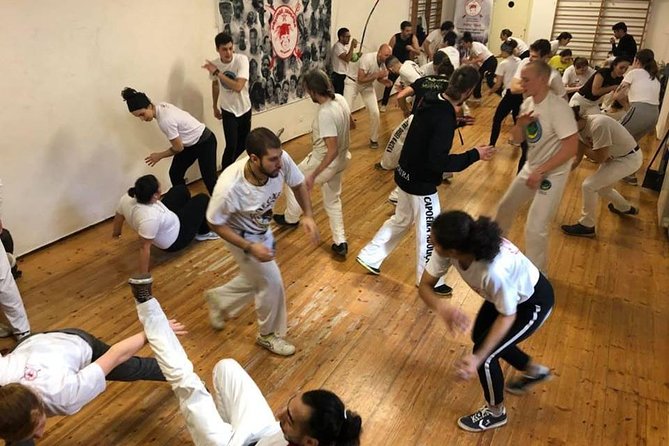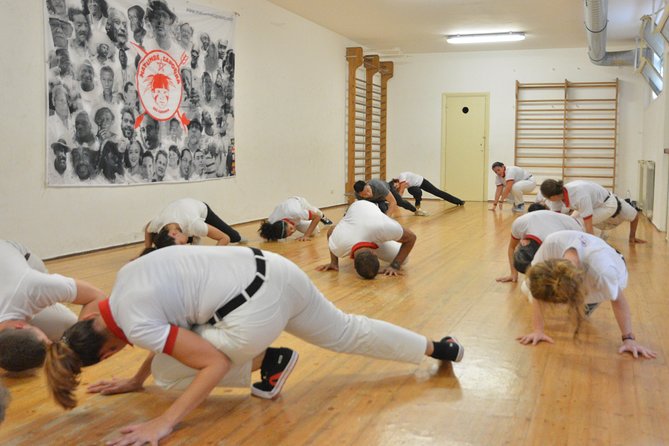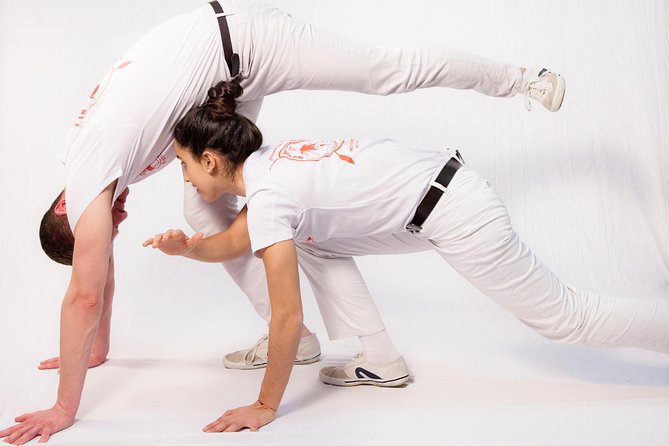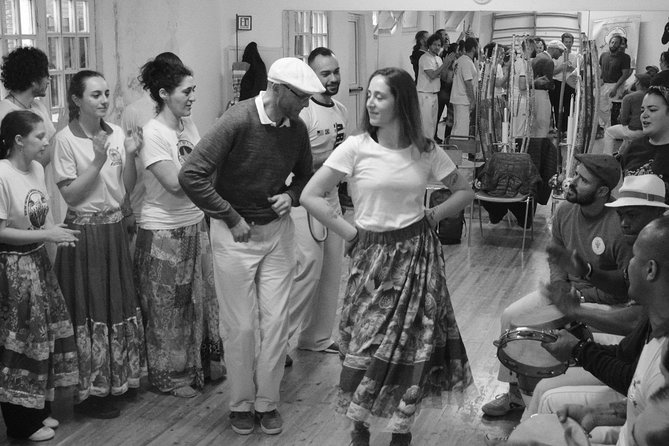Capoeira, the captivating Afro-Brazilian martial art, is making its way to Rome. The Centro di Cultura Brasiliana – Ilê Odara Roma is hosting an immersive capoeira workshop that promises to transport participants to the vibrant heart of Brazil. Led by experienced instructors, this unique opportunity allows attendees to explore the fundamental movements, rhythmic elements, and rich cultural heritage of this dynamic art form. Whether you’re a seasoned practitioner or curious newcomer, the workshop offers a chance to explore the captivating world of capoeira and uncover its mesmerizing blend of physical prowess and cultural significance.
Key Points

- The workshop is held at the Centro di Cultura Brasiliana – Ilê Odara Roma, near the Piramide Metro station.
- The workshop provides an engaging introduction to fundamental Capoeira movements, techniques, and the art’s history and cultural significance.
- Participants will explore the rhythmic elements of Capoeira, including the role of the berimbau, in a supportive environment.
- The workshop is led by experienced instructors who guide both the physical and cultural aspects of Capoeira.
- The workshop is not wheelchair accessible, but service animals are allowed, and the venue is stroller accessible.
What Is Capoeira?

Capoeira is an Afro-Brazilian martial art that combines elements of dance, acrobatics, and music. It was developed by enslaved Africans in Brazil as a form of self-defense, disguised as a dance to avoid detection by their captors.
Capoeira features rapid, fluid movements, kicks, and evasive maneuvers, all performed to the rhythm of traditional instruments and call-and-response songs. Practitioners engage in a game-like sparring session called a roda, where they take turns demonstrating their skills and creativity.
Capoeira isn’t only a physical practice but also a cultural expression that reflects the rich heritage of the African diaspora in Brazil. It has gained popularity worldwide as a unique and captivating art form.
Here are more great tours and experiences we've reviewed in Rome
Benefits of Capoeira

Beyond its captivating dance-like movements, Capoeira offers an array of benefits that extend far beyond the physical realm.
It’s an art form that cultivates mental agility, building quick reflexes and strategic thinking essential for navigating the flow of the game. Practitioners also develop core strength, flexibility, and balance, improving overall fitness.
But Capoeira’s benefits go deeper, fostering a strong sense of community and cultural identity. The call-and-response rhythms and songs connect practitioners to the rich heritage of Afro-Brazilian tradition.
Through this immersive experience, participants enhance their self-confidence, discipline, and respect for others – qualities that transcend the boundaries of the Capoeira circle.
Capoeira Origins and History
Although its precise origins remain shrouded in mystery, Capoeira’s history is inextricably linked to the experiences of enslaved Africans in Brazil.
Brought to Brazil during the colonial era, these individuals combined elements of dance, martial arts, and music to create Capoeira – a unique form of self-defense that also served as a means of cultural expression and resistance against oppression.
Over time, Capoeira evolved, with distinct regional styles emerging across Brazil.
Today, this vibrant art form continues to be practiced and celebrated worldwide, reflecting its enduring legacy as a symbol of resilience, cultural heritage, and the human spirit.
Capoeira Movements and Techniques

At the heart of Capoeira lies a captivating repertoire of movements and techniques that dancers and practitioners masterfully execute. From lightning-fast kicks and agile cartwheels to powerful handstands and graceful flowing transitions, the art form showcases a dynamic blend of physical prowess and rhythmic expression.
Capoeira’s dance-like motions, known as "moves," are deeply rooted in the culture’s African heritage and often mimic the movements of animals. Practitioners hone their skills through intensive training, developing a keen sense of balance, coordination, and improvisation.
These techniques aren’t merely physical feats but a means of storytelling, allowing Capoeiristas to engage in a captivating dialogue through their bodies.
Capoeira Music and Instruments
Capoeira’s captivating physicality is matched by its rich musical heritage. At the heart of a Capoeira roda (circle) are the instruments that drive the rhythmic pulse and set the mood.
The most prominent are:
- Berimbau – A single-string percussion instrument that sets the tempo and guides the flow of the game.
- Pandeiro – A type of tambourine that provides a steady beat.
- Atabaque – A tall, barrel-shaped drum that adds depth and resonance.
- Agogô – A pair of bell-like instruments that punctuate the rhythm.
These instruments, combined with call-and-response chants, create a captivating soundscape that infuses the Capoeira experience with a sense of tradition and cultural identity.
- Expert Guided Tour of Colosseum Arena OR Underground, and Forum
- Tuscany Region Day Trip From Rome With Lunch & Wine Tasting
- Colosseum Underground and Ancient Rome Small Group – 6 People Max
- Skip-the-Line Vatican, Sistine Chapel & St. Peters | Small Group
- Vatican Museums, Sistine Chapel & St Peter’s Basilica Guided Tour
- Gladiator’S Gate: Special Access Colosseum Tour With Arena Floor
Capoeira Etiquette and Culture
Capoeira, as a martial art and cultural practice, carries with it a distinct etiquette and set of traditions that practitioners are expected to uphold.
Respect for the art, one’s fellow capoeiristas, and the roda (the circular formation where capoeira is played) is paramount. Proper attire, such as the traditional white uniform, is required. Participants must await their turn to enter the roda and engage in the game, respecting the ongoing flow.
Movements and techniques are executed with control and precision, avoiding unnecessary aggression. Throughout the practice, participants are expected to maintain a sense of rhythmic connection, responding to the cadence of the music.
Upholding these cultural norms fosters a harmonious and meaningful capoeira experience.
What to Expect at the Workshop

Participants can expect an engaging and immersive introduction to the art of capoeira during this workshop.
The session will cover:
- Fundamental capoeira movements and techniques, including ginga, esquiva, and basic kicks.
- The history and cultural significance of capoeira, with insights into its roots in Afro-Brazilian traditions.
- The rhythmic elements of capoeira, including the role of the berimbau, a traditional Brazilian musical instrument.
- Opportunities to practice capoeira’s fluid and acrobatic movements in a supportive and encouraging environment.
The workshop will be led by experienced instructors who’ll guide participants through the physical and cultural aspects of this dynamic martial art form.
Getting to the Workshop Location
The Centro di Cultura Brasiliana – Ilê Odara Roma, where the capoeira workshop takes place, is conveniently located and accessible via public transportation.
The meeting point is a short walk from the Piramide Metro station on the Metro B line. The workshop location is easily reachable by public transit, making it convenient for participants.
While the venue isn’t wheelchair accessible, it’s stroller accessible, and service animals are allowed.
The workshop’s end point is the same as the meeting point, so participants can easily return to their starting location after the experience.
Frequently Asked Questions
Is Prior Experience in Capoeira Required to Attend the Workshop?
No, prior experience in capoeira is not required to attend the workshop. The workshop is open to participants of all skill levels, from beginners to experienced practitioners.
What Is the Dress Code for the Capoeira Workshop?
The dress code for the capoeira workshop is comfortable sports equipment. Participants are advised to wear lightweight, breathable clothing that allows for easy movement and flexibility during the physical activities involved in the workshop.
Can Participants Bring Their Own Capoeira Equipment?
Participants can bring their own capoeira equipment to the workshop, as the inclusions only mention bottled water and comfortable sports equipment. However, the workshop organizer doesn’t specify if participants must use the provided equipment.
Are There Any Age Restrictions for the Capoeira Workshop?
The workshop doesn’t mention any age restrictions. Most travelers can participate, but it’s recommended to check with the organizers if there are any age limits or suitability requirements for the Capoeira activities.
Is There a Break or Rest Period During the Capoeira Workshop?
The capoeira workshop likely includes a break or rest period to allow participants to catch their breath and hydrate. Breaks are common during physical activities to prevent fatigue and ensure participants can fully engage throughout the session.
Recap
Capoeira is a unique Afro-Brazilian art form that combines dance, martial arts, and music. The upcoming workshop in Rome offers an immersive experience to learn the fundamentals of this dynamic practice. Participants can expect to explore the history, movements, and cultural elements of Capoeira while practicing in a supportive environment. It’s an excellent opportunity to connect with this vibrant tradition and expand one’s understanding of this captivating art.
More Workshops & Classes in Rome
More Tour Reviews in Rome
- Dark Heart of Rome: Facts, Legends, and Mystery Tour
- Rome: Colosseum & Forum With Audio Guide App -Optional Arena
- Dark Heart of Rome – Facts, Legend & Mystery Walking Tour
- Rome: Colosseum, Ancient Rome Tour or Self AudioGuided Tour
- Rome: Trevi Fountain, Spanish Steps & Pantheon Walking Tour
- Rome: Basilica of San Clemente, San Giovanni, and Scala Santa
Not for you? Here's more things to do in Rome we have recnetly reviewed
- Rome: Trastevere and Jewish Ghetto Highlights Tour
- Vatican City: St. Peters Basilica Walking Tour
- Rome: City Highlights Small Group Walking Tour by Night
- Rome: Castel SantAngelo Skip-the-Line Entry Ticket
- Rome: Skip-the-Line Castel SantAngelo Tickets & Audio Guide
- Rome: Treasure Hunt for Kids and Families Trevi and Pantheon
- Secrets of the Passetto: Vaticans Hidden Path of Mystery
- Rome: Jubilee Pilgrimage Walking Tour
- Rome: In-Depth St. Peters Basilica Tour With Tour Guide
- Rome: Trastevere & Tiber Island Street Food Tour at Sunset
- Rome:St. Peters Basilica Tour, Exclusive Underground Access
- Rome: Castel Sant’ Angelo Ticket and Audio Guide
